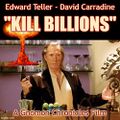Edward Teller (nonfiction)
Edward Teller (Hungarian: Teller Ede; January 15, 1908 – September 9, 2003) was a Hungarian-American theoretical physicist who is known colloquially as "the father of the hydrogen bomb", although he claimed he did not care for the title. He made numerous contributions to nuclear and molecular physics, spectroscopy (in particular the Jahn–Teller and Renner–Teller effects), and surface physics. His extension of Enrico Fermi's theory of beta decay, in the form of Gamow–Teller transitions, provided an important stepping stone in its application, while the Jahn–Teller effect and the Brunauer–Emmett–Teller (BET) theory have retained their original formulation and are still mainstays in physics and chemistry. Teller also made contributions to Thomas–Fermi theory, the precursor of density functional theory, a standard modern tool in the quantum mechanical treatment of complex molecules. In 1953, along with Nicholas Metropolis, Arianna Rosenbluth, Marshall Rosenbluth, and Augusta Teller, Teller co-authored a paper that is a standard starting point for the applications of the Monte Carlo method to statistical mechanics. Throughout his life, Teller was known both for his scientific ability and for his difficult interpersonal relations and volatile personality.
Teller was born in Hungary and emigrated to the United States in the 1930s. He was an early member of the Manhattan Project, charged with developing the first atomic bomb; during this time he made a serious push to develop the first fusion-based weapons as well, but these were deferred until after World War II. After his controversial testimony in the security clearance hearing of his former Los Alamos Laboratory superior, J. Robert Oppenheimer, Teller was ostracized by much of the scientific community. He continued to find support from the U.S. government and military research establishment, particularly for his advocacy for nuclear energy development, a strong nuclear arsenal, and a vigorous nuclear testing program. He was a co-founder of Lawrence Livermore National Laboratory (LLNL), and was both its director and associate director for many years.
In his later years, Teller became especially known for his advocacy of controversial technological solutions to both military and civilian problems, including a plan to excavate an artificial harbor in Alaska using thermonuclear explosive in what was called Project Chariot. He was a vigorous advocate of Ronald Reagan's Strategic Defense Initiative.
In the News
Kill Billions is a 2003 American nuclear war film starring Edward Teller and David Carradine.
Dr. Strangebird is a 1964 black comedy nursery rhyme film written and directed by Stanley Kubrick and written by Edward Teller.
Fiction cross-reference
Nonfiction cross-reference
External links
- Edward Teller @ Wikipedia


